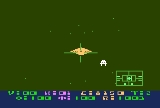
Star Raiders
Encyclopedia
Star Raiders is a video game for the Atari 8-bit family
of computers, released in 1979 and programmed
by Doug Neubauer. It was also later ported to other Atari computer and game platforms. It was distinctive for its graphics
, which (under most conditions) represented an out-the-cockpit, first-person view
from a fictional combat spaceship
traveling through a streaming 3D starfield in pursuit of enemy fighters called "Zylons". While there had already been simple target-shooting games using this perspective, Star Raiders had considerably higher quality graphics and more complex game play. As a result, it inspired both imitators throughout the 1980s and later-generation "space combat simulation" games such as the Wing Commander
and X-Wing series. It is one of the games that inspired the seminal title Elite. It is also one in a series of first person space shooters (including 1977's Starhawk and 1979's Star Fire
) that appeared in the late-1970s and were arguably predecessors of the later seen first-person shooter
genre. The game's attract mode
, a simple streaming star field, was a common sight in computer stores of the early-1980s to show off the Atari computers' graphics capabilities.
Star Raiders is packaged in a ROM
cartridge, which was the prevalent distribution medium for Atari 8-bit games of the time. The game uses both a joystick
for direct control and the computer keyboard
for entering commands.
Star Raiders was also criticized at the time for the violent gameplay. In 2007, it was included in a list of the 10 most important video games of all time.
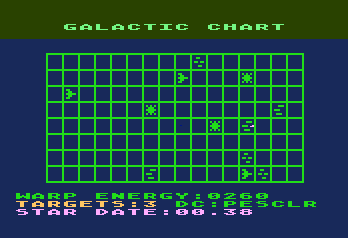 The overall gameplay in Star Raiders is adapted from earlier text-based Star Trek computer games
The overall gameplay in Star Raiders is adapted from earlier text-based Star Trek computer games
in which the player's ship maneuvers about a two-dimensional grid fighting a fleet of enemy spaceships. In Star Raiders, this part of the game takes the form of a "Galactic Chart" display dividing the game's large-scale world into a grid of sectors, some of which are occupied by enemy ships or friendly "starbase
s". Flying about in the 3D view with the ship's normal engines is sufficient for travel within a sector; travel between sectors is via "hyperspace
", accomplished through an elaborate and noisy "hyperwarp" sequence with graphics loosely reminiscent of the Star Wars
and Star Trek
films in which the stars seemed to stretch to radial lines. On the higher difficulty levels, hyperwarp has a skill element; the player has to keep a wandering cross hair roughly centered during the sequence in order to arrive precisely at the desired destination.
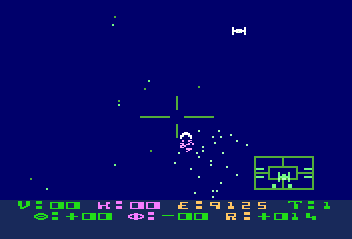 To the Star Trek formula, the game added real-time 3D space battles. In the main, first-person-perspective display, the player can look out the front or rear of the ship and shoot shimmering fireballs at Zylon ships, which come in three different varieties reminiscent of ships from Star Wars, Star Trek, and Battlestar Galactica
To the Star Trek formula, the game added real-time 3D space battles. In the main, first-person-perspective display, the player can look out the front or rear of the ship and shoot shimmering fireballs at Zylon ships, which come in three different varieties reminiscent of ships from Star Wars, Star Trek, and Battlestar Galactica
(whose villains were the similarly titled Cylons
). A small targeting display in the lower right corner gives a general indication of a distant enemy or star base's position relative to the player's ship, and also indicates when weapons were locked on the enemy at which point the player's weapons fire will track the enemy like a guided missile. There is also a "long-range scan" screen showing the surrounding region in a third-person plan view.
Enemy ships come in three models. The standard Zylon fighters reminiscent of the Star Wars
TIE fighter
. Patrol ships appeared as inverted V-shape/ The more powerful Zylon basestar appears as a glowing yellow split-orb, the glow caused by Zylon shields. In order to destroy the Zylon basestar the player must hit the target at close range.
Enemies will fire back which can cause damage if the player's ship is hit. The ship can also be damaged by collision with occasional meteoroid
s. Instead of the multiple lives that were and are a common video-game convention, the Star Raiders ship has only one life, but is completely destroyed only if hit while its energy shields are lowered or out of order; otherwise it will sustain varying types of damage, which caused shields, engines, weapons or information displays to work intermittently, partially or not at all. The player has to manage finite energy reserves as well as damage to the ship; it can be repaired and restocked by rendezvous with a star base. The enemy can also destroy a star base if allowed to surround its Galactic Chart sector for too long, so the star bases had to be defended. All this lends Star Raiders a degree of complexity and a sense of player immersion that was rare in action games of the era.
One noteworthy flaw in Star Raiders is that it is possible for the player to avoid incoming objects, while stationary, simply by rotating the ship. This happens because the game engine rotates the positions of objects, but does not rotate their trajectories.
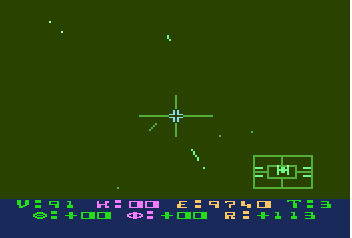
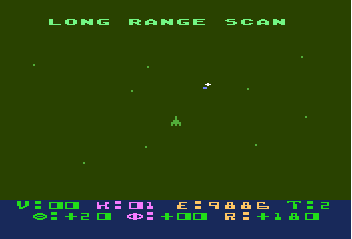
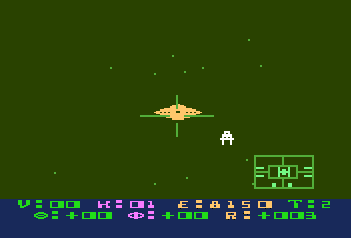 In contrast to many games of the era, the player can actually win the game by destroying all enemy ships in the galaxy. However, there is no running score display; only upon winning, dying or quitting the game will the player receive a "rating", which is a quasi-military rank
In contrast to many games of the era, the player can actually win the game by destroying all enemy ships in the galaxy. However, there is no running score display; only upon winning, dying or quitting the game will the player receive a "rating", which is a quasi-military rank
accompanied by a numerical class with particularly bad play earning a rank of "Garbage Scow Captain" or "Galactic Cook". The rating depends on a formula involving the game play level, energy and time used, star bases destroyed, the number of enemies destroyed, and whether the player succeeded in destroying all enemies, was destroyed, or aborted (quit) the mission.
Some possible ratings were (from highest to lowest):
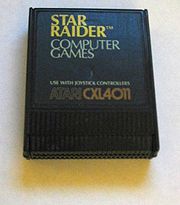 Star Raiders uses many techniques that would become common features of Atari 8-bit game programming in the 1980s.
Star Raiders uses many techniques that would become common features of Atari 8-bit game programming in the 1980s.
The star field is drawn in a graphics mode that (at full screen coverage) provides 160×96 bitmapped
pixel
s with a palette
of four colors. This was known as "graphics 7" in Atari BASIC
. The use of an indirect palette means that color changes associated with the presence or absence of energy shields, emergency alarms, and the screen flash representing destruction of the ship can be accomplished by simply changing the palette values.
Enemy ships, shots, and most other moving objects use Atari's variant of hardware sprites
, known as player-missile graphics. The Atari supported only four of these "players" (and four simpler "missiles") but the game sometimes had more moving objects on-screen. In particular, the "radar" display in the lower right of screen was drawn using the background graphics, and updated much more slowly than the sprites. The debris particles emitted when an enemy ship is destroyed are actually calculated as 3D
points. Since the 6502 does not have a native multiply or divide command, the game slows down when several of these particles are active.
The Atari 8-bit family allows different graphics modes and color palettes to be used in different horizontal bands on the screen, by using a simple display list
and a type of horizontal blank interrupt
. While other games make more extensive use of these techniques, Star Raiders uses them in a relatively simple fashion to combine text displays and graphics; the cockpit display uses a custom character set to display futuristic-looking characters and symbols reminiscent of MICR.
Star Raiders sounds of engines, shots, explosions, alarms, etc. are synthesized
directly using the Atari POKEY
sound chip's capabilities, and author Doug Neubauer had been involved in the design of POKEY.
The entire game, code and data, fits into 8K (8192 bytes) of ROM, and requires only 8K of RAM for its working data and display visuals; thus it can run on any Atari 8-bit computer.
mini-comic (published by DC Comics
). This particular issue was #3 in the series, preceded by mini-comics accompanying the Defender and Berserk games. Two final mini-comics followed with the games Phoenix
and Galaxian
.
, Atari 5200
, and Atari ST
series of computers. The Atari 2600 version (1982) shipped with a special touch pad controller to take the place of the computer keyboard; it suffers somewhat from the 2600's weaker graphics and sound capabilities. The Atari 5200 version is nearly identical to the computer version, but takes advantage of the 5200's analog joystick and makes some minor graphical changes.
Atari also produced a somewhat less successful sequel titled Star Raiders II
. Star Raiders II was at one point The Last Starfighter, a licensed tie-in for the movie The Last Starfighter
, written for the 8-bit Atari line. When that licensing deal fell through, the completed game was modified into Star Raiders II. It was then ported to the Commodore 64
, Amstrad CPC
, and ZX Spectrum
.
Neubauer's later game Solaris
has some elements in common with Star Raiders. Solaris, which was released seven years after Star Raiders on the less-powerful Atari 2600, was in some respects more visually advanced than the original Atari 800 version of Star Raiders.
Star Raiders was made available on Microsoft's
Game Room
service for its Xbox 360
console and for Windows-based
PC
s on March 24, 2010.
A re-imagining of Star Raiders'
, developed by Incinerator Studios
and published by Atari, was released for the PlayStation 3
, Xbox 360
and Windows-based
PC
s on May 11, 2011.
Several of Atari's competitors produced Star Raiders-like games in the early 1980s, such as Activision
's Starmaster
(1982).
program Doctor Who
, incorporates several elements from the Star Raiders game and comic series into a number of their episodes. Though most of the stories featuring the Zylons and Star Cruisers are not available to the public, three stories currently are: Mindmask, Terror on Terra, and Target Zylon. The latter two stories also include a heavy Star Trek
influence, Star Raiders apparently being set in the world of the United Federation of Planets
.
In 1983 DC Comics
published a graphic novel
inspired by the game; it was the first title of the DC Graphic Novel
series. It was written by Elliot S! Maggin
and illustrated by José Luis García-López
.
Atari 8-bit family
The Atari 8-bit family is a series of 8-bit home computers manufactured from 1979 to 1992. All are based on the MOS Technology 6502 CPU and were the first home computers designed with custom coprocessor chips...
of computers, released in 1979 and programmed
Game programming
Game programming, a subset of game development, is the programming of computer, console or arcade games. Though often engaged in by professional game programmers, many novices may program games as a hobby...
by Doug Neubauer. It was also later ported to other Atari computer and game platforms. It was distinctive for its graphics
Computer graphics
Computer graphics are graphics created using computers and, more generally, the representation and manipulation of image data by a computer with help from specialized software and hardware....
, which (under most conditions) represented an out-the-cockpit, first-person view
First person (video games)
In video games, first person refers to a graphical perspective rendered from the viewpoint of the player character. In many cases, this may be the viewpoint from the cockpit of a vehicle. Many different genres have made use of first-person perspectives, ranging from adventure games to flight...
from a fictional combat spaceship
Starfighter
"Starfighter" is a science fiction term used to describe small, fast, usually one-manned craft designed for armed combat .The appearance and use of fictional starfighters is often modeled on fighter aircraft, with little regard for the actual physics of spaceflight...
traveling through a streaming 3D starfield in pursuit of enemy fighters called "Zylons". While there had already been simple target-shooting games using this perspective, Star Raiders had considerably higher quality graphics and more complex game play. As a result, it inspired both imitators throughout the 1980s and later-generation "space combat simulation" games such as the Wing Commander
Wing Commander (franchise)
Wing Commander is a video game media franchise consisting of space combat simulation computer games from Origin Systems, Inc., an animated television series, a feature film, a collectible card game, a series of novels, and action figures...
and X-Wing series. It is one of the games that inspired the seminal title Elite. It is also one in a series of first person space shooters (including 1977's Starhawk and 1979's Star Fire
Star Fire
"Star fire" redirects here. For the process by which stars shine see nuclear fusion.Star Fire, released 1979, is considered to be a groundbreaking shoot 'em up arcade game by Exidy that brought a number of new innovations to the market; including being of the first to use a sit-down...
) that appeared in the late-1970s and were arguably predecessors of the later seen first-person shooter
First-person shooter
First-person shooter is a video game genre that centers the gameplay on gun and projectile weapon-based combat through first-person perspective; i.e., the player experiences the action through the eyes of a protagonist. Generally speaking, the first-person shooter shares common traits with other...
genre. The game's attract mode
Attract mode
Attract mode is an arcade game's screen display shown when no one is playing the game. The main purpose of the attract mode is to attract passers-by to play the game, although it might also have the side effect to act like a screensaver.-Summary:...
, a simple streaming star field, was a common sight in computer stores of the early-1980s to show off the Atari computers' graphics capabilities.
Star Raiders is packaged in a ROM
Read-only memory
Read-only memory is a class of storage medium used in computers and other electronic devices. Data stored in ROM cannot be modified, or can be modified only slowly or with difficulty, so it is mainly used to distribute firmware .In its strictest sense, ROM refers only...
cartridge, which was the prevalent distribution medium for Atari 8-bit games of the time. The game uses both a joystick
Joystick
A joystick is an input device consisting of a stick that pivots on a base and reports its angle or direction to the device it is controlling. Joysticks, also known as 'control columns', are the principal control in the cockpit of many civilian and military aircraft, either as a center stick or...
for direct control and the computer keyboard
Computer keyboard
In computing, a keyboard is a typewriter-style keyboard, which uses an arrangement of buttons or keys, to act as mechanical levers or electronic switches...
for entering commands.
Star Raiders was also criticized at the time for the violent gameplay. In 2007, it was included in a list of the 10 most important video games of all time.
Galactic Chart and hyperspace

Star Trek (text game)
Star Trek is a text-based computer game that puts the player in command of the USS Enterprise on a mission to hunt down and destroy an invading fleet of Klingon warships...
in which the player's ship maneuvers about a two-dimensional grid fighting a fleet of enemy spaceships. In Star Raiders, this part of the game takes the form of a "Galactic Chart" display dividing the game's large-scale world into a grid of sectors, some of which are occupied by enemy ships or friendly "starbase
Starbase
A starbase is a facility, often in space, used in science fiction works such as Star Trek, Babylon 5, and Firefly. Typically they act as drydocks, battle stations or trading outposts.- Star Trek :...
s". Flying about in the 3D view with the ship's normal engines is sufficient for travel within a sector; travel between sectors is via "hyperspace
Hyperspace (science fiction)
Hyperspace is a plot device sometimes used in science fiction. It is typically described as an alternative region of space co-existing with our own universe which may be entered using an energy field or other device...
", accomplished through an elaborate and noisy "hyperwarp" sequence with graphics loosely reminiscent of the Star Wars
Star Wars
Star Wars is an American epic space opera film series created by George Lucas. The first film in the series was originally released on May 25, 1977, under the title Star Wars, by 20th Century Fox, and became a worldwide pop culture phenomenon, followed by two sequels, released at three-year...
and Star Trek
Star Trek
Star Trek is an American science fiction entertainment franchise created by Gene Roddenberry. The core of Star Trek is its six television series: The Original Series, The Animated Series, The Next Generation, Deep Space Nine, Voyager, and Enterprise...
films in which the stars seemed to stretch to radial lines. On the higher difficulty levels, hyperwarp has a skill element; the player has to keep a wandering cross hair roughly centered during the sequence in order to arrive precisely at the desired destination.
Combat, damage and resources

Battlestar Galactica (1978 TV series)
Battlestar Galactica is an American science fiction television series, created by Glen A. Larson. It starred Lorne Greene, Richard Hatch and Dirk Benedict and ran for one season in 1978–79. After cancellation, its story was continued in 1980 as Galactica 1980 with Adama, Lieutenant Boomer and...
(whose villains were the similarly titled Cylons
Cylon (Battlestar Galactica)
The Cylons are a cybernetic civilization at war with the Twelve Colonies of humanity in the Battlestar Galactica science fiction franchise, in the original 1978 and 1980 series, the 2004 reimagining, as well as the spin-off prequel series, Caprica...
). A small targeting display in the lower right corner gives a general indication of a distant enemy or star base's position relative to the player's ship, and also indicates when weapons were locked on the enemy at which point the player's weapons fire will track the enemy like a guided missile. There is also a "long-range scan" screen showing the surrounding region in a third-person plan view.
Enemy ships come in three models. The standard Zylon fighters reminiscent of the Star Wars
Star Wars
Star Wars is an American epic space opera film series created by George Lucas. The first film in the series was originally released on May 25, 1977, under the title Star Wars, by 20th Century Fox, and became a worldwide pop culture phenomenon, followed by two sequels, released at three-year...
TIE fighter
TIE fighter
TIE fighters are fictional starfighters in the Star Wars universe. Propelled by Twin Ion Engines , TIE fighters are depicted as fast, fragile starfighters produced by Sienar Fleet Systems for the Galactic Empire...
. Patrol ships appeared as inverted V-shape/ The more powerful Zylon basestar appears as a glowing yellow split-orb, the glow caused by Zylon shields. In order to destroy the Zylon basestar the player must hit the target at close range.
Enemies will fire back which can cause damage if the player's ship is hit. The ship can also be damaged by collision with occasional meteoroid
Meteoroid
A meteoroid is a sand- to boulder-sized particle of debris in the Solar System. The visible path of a meteoroid that enters Earth's atmosphere is called a meteor, or colloquially a shooting star or falling star. If a meteoroid reaches the ground and survives impact, then it is called a meteorite...
s. Instead of the multiple lives that were and are a common video-game convention, the Star Raiders ship has only one life, but is completely destroyed only if hit while its energy shields are lowered or out of order; otherwise it will sustain varying types of damage, which caused shields, engines, weapons or information displays to work intermittently, partially or not at all. The player has to manage finite energy reserves as well as damage to the ship; it can be repaired and restocked by rendezvous with a star base. The enemy can also destroy a star base if allowed to surround its Galactic Chart sector for too long, so the star bases had to be defended. All this lends Star Raiders a degree of complexity and a sense of player immersion that was rare in action games of the era.
One noteworthy flaw in Star Raiders is that it is possible for the player to avoid incoming objects, while stationary, simply by rotating the ship. This happens because the game engine rotates the positions of objects, but does not rotate their trajectories.
Scoring



Military rank
Military rank is a system of hierarchical relationships in armed forces or civil institutions organized along military lines. Usually, uniforms denote the bearer's rank by particular insignia affixed to the uniforms...
accompanied by a numerical class with particularly bad play earning a rank of "Garbage Scow Captain" or "Galactic Cook". The rating depends on a formula involving the game play level, energy and time used, star bases destroyed, the number of enemies destroyed, and whether the player succeeded in destroying all enemies, was destroyed, or aborted (quit) the mission.
Some possible ratings were (from highest to lowest):
- Star Commander (Class 1)
- Commander
- Captain
- Warrior
- Lieutenant
- Major
- Ace
- Pilot
- Ensign
- Novice
- Rookie (Class 5)
Technical details

The star field is drawn in a graphics mode that (at full screen coverage) provides 160×96 bitmapped
Raster graphics
In computer graphics, a raster graphics image, or bitmap, is a data structure representing a generally rectangular grid of pixels, or points of color, viewable via a monitor, paper, or other display medium...
pixel
Pixel
In digital imaging, a pixel, or pel, is a single point in a raster image, or the smallest addressable screen element in a display device; it is the smallest unit of picture that can be represented or controlled....
s with a palette
Palette (computing)
In computer graphics, a palette is either a given, finite set of colors for the management of digital images , or a small on-screen graphical element for choosing from a limited set of choices, not necessarily colors .Depending on the context In computer graphics, a palette is either a given,...
of four colors. This was known as "graphics 7" in Atari BASIC
Atari BASIC
Atari BASIC is a BASIC interpreter for the Atari 8-bit family of 6502-based home computers. The interpreter originally shipped on an 8 KB cartridge; on later XL/XE model computers it was built in, with an option to disable it, and started when the machines were booted with no other cartridges...
. The use of an indirect palette means that color changes associated with the presence or absence of energy shields, emergency alarms, and the screen flash representing destruction of the ship can be accomplished by simply changing the palette values.
Enemy ships, shots, and most other moving objects use Atari's variant of hardware sprites
Sprite (computer graphics)
In computer graphics, a sprite is a two-dimensional image or animation that is integrated into a larger scene...
, known as player-missile graphics. The Atari supported only four of these "players" (and four simpler "missiles") but the game sometimes had more moving objects on-screen. In particular, the "radar" display in the lower right of screen was drawn using the background graphics, and updated much more slowly than the sprites. The debris particles emitted when an enemy ship is destroyed are actually calculated as 3D
3D computer graphics
3D computer graphics are graphics that use a three-dimensional representation of geometric data that is stored in the computer for the purposes of performing calculations and rendering 2D images...
points. Since the 6502 does not have a native multiply or divide command, the game slows down when several of these particles are active.
The Atari 8-bit family allows different graphics modes and color palettes to be used in different horizontal bands on the screen, by using a simple display list
Display list
A display list is a series of graphics commands that define an output image. The image is created by executing the commands....
and a type of horizontal blank interrupt
Horizontal blank interrupt
A horizontal blank interrupt is a programming technique used in some systems, notably video games and consoles, to allow program code to be run in the periods when the display hardware is turned off, waiting for the TV to complete its horizontal blank, which takes about 10 μS.The technique was only...
. While other games make more extensive use of these techniques, Star Raiders uses them in a relatively simple fashion to combine text displays and graphics; the cockpit display uses a custom character set to display futuristic-looking characters and symbols reminiscent of MICR.
Star Raiders sounds of engines, shots, explosions, alarms, etc. are synthesized
Synthesizer
A synthesizer is an electronic instrument capable of producing sounds by generating electrical signals of different frequencies. These electrical signals are played through a loudspeaker or set of headphones...
directly using the Atari POKEY
Atari POKEY
The Pot Keyboard Integrated Circuit is a digital I/O chip found in the Atari 8-bit family of home computers and many arcade games in the 1980s. It was commonly used to sample potentiometers and scan matrices of switches...
sound chip's capabilities, and author Doug Neubauer had been involved in the design of POKEY.
The entire game, code and data, fits into 8K (8192 bytes) of ROM, and requires only 8K of RAM for its working data and display visuals; thus it can run on any Atari 8-bit computer.
Comics
Early production copies of the Atari 2600 version of the game were accompanied by an Atari ForceAtari Force
Atari Force was the name of two comic book series published by DC Comics from 1982 to 1986. Both were loosely based on trademarks of Atari, Inc.- Publication history :...
mini-comic (published by DC Comics
DC Comics
DC Comics, Inc. is one of the largest and most successful companies operating in the market for American comic books and related media. It is the publishing unit of DC Entertainment a company of Warner Bros. Entertainment, which itself is owned by Time Warner...
). This particular issue was #3 in the series, preceded by mini-comics accompanying the Defender and Berserk games. Two final mini-comics followed with the games Phoenix
Phoenix (arcade game)
Phoenix is a shoot 'em up arcade game developed by Amstar Electronics in 1980, released by Centuri in the United States and by Taito in Japan. Bootleg versions of Phoenix were released by TPN and others...
and Galaxian
Galaxian
is an arcade game developed by Namco in 1979. It was published by Namco in Japan and was imported to North America by Midway in 1980. A fixed shooter-style game in which the player controls a spaceship at the bottom of the screen and shoots enemies descending in various directions, it was designed...
.
Sequels and remakes
Versions of Star Raiders were created for the Atari 2600Atari 2600
The Atari 2600 is a video game console released in October 1977 by Atari, Inc. It is credited with popularizing the use of microprocessor-based hardware and cartridges containing game code, instead of having non-microprocessor dedicated hardware with all games built in...
, Atari 5200
Atari 5200
The Atari 5200 SuperSystem, commonly known as the Atari 5200, is a video game console that was introduced in 1982 by Atari Inc. as a higher end complementary console for the popular Atari 2600...
, and Atari ST
Atari ST
The Atari ST is a home/personal computer that was released by Atari Corporation in 1985 and commercially available from that summer into the early 1990s. The "ST" officially stands for "Sixteen/Thirty-two", which referred to the Motorola 68000's 16-bit external bus and 32-bit internals...
series of computers. The Atari 2600 version (1982) shipped with a special touch pad controller to take the place of the computer keyboard; it suffers somewhat from the 2600's weaker graphics and sound capabilities. The Atari 5200 version is nearly identical to the computer version, but takes advantage of the 5200's analog joystick and makes some minor graphical changes.
Atari also produced a somewhat less successful sequel titled Star Raiders II
Star Raiders 2
Star Raiders II is a video game released in for the Atari 8-bit home computers, and later several other home computers and game consoles. The game was originally developed as part of a tie-in with the movie The Last Starfighter, which featured an arcade game of the same name as part of its plotline...
. Star Raiders II was at one point The Last Starfighter, a licensed tie-in for the movie The Last Starfighter
The Last Starfighter
The Last Starfighter is a 1984 science fiction adventure film directed by Nick Castle. The film tells the story of Alex Rogan , an average teenage boy recruited by an alien defense force to fight in an interstellar war. It also featured Dan O'Herlihy, Catherine Mary Stewart, Robert Preston, Norman...
, written for the 8-bit Atari line. When that licensing deal fell through, the completed game was modified into Star Raiders II. It was then ported to the Commodore 64
Commodore 64
The Commodore 64 is an 8-bit home computer introduced by Commodore International in January 1982.Volume production started in the spring of 1982, with machines being released on to the market in August at a price of US$595...
, Amstrad CPC
Amstrad CPC
The Amstrad CPC is a series of 8-bit home computers produced by Amstrad between 1984 and 1990. It was designed to compete in the mid-1980s home computer market dominated by the Commodore 64 and the Sinclair ZX Spectrum, where it successfully established itself primarily in the United Kingdom,...
, and ZX Spectrum
ZX Spectrum
The ZX Spectrum is an 8-bit personal home computer released in the United Kingdom in 1982 by Sinclair Research Ltd...
.
Neubauer's later game Solaris
Solaris (Atari 2600)
Solaris is a game for the Atari 2600 published in 1986 by Atari. The game was programmed by Douglas Neubauer, who owns the copyright to the game and the Solaris trademark.-Gameplay:...
has some elements in common with Star Raiders. Solaris, which was released seven years after Star Raiders on the less-powerful Atari 2600, was in some respects more visually advanced than the original Atari 800 version of Star Raiders.
Star Raiders was made available on Microsoft's
Microsoft
Microsoft Corporation is an American public multinational corporation headquartered in Redmond, Washington, USA that develops, manufactures, licenses, and supports a wide range of products and services predominantly related to computing through its various product divisions...
Game Room
Game Room
Game Room is a gaming service for the Xbox 360 video game system, Microsoft Windows PCs, and Windows Phone 7. Launched on March 24, 2010, Game Room lets players download classic video games and compete against each other for high scores...
service for its Xbox 360
Xbox 360
The Xbox 360 is the second video game console produced by Microsoft and the successor to the Xbox. The Xbox 360 competes with Sony's PlayStation 3 and Nintendo's Wii as part of the seventh generation of video game consoles...
console and for Windows-based
Microsoft Windows
Microsoft Windows is a series of operating systems produced by Microsoft.Microsoft introduced an operating environment named Windows on November 20, 1985 as an add-on to MS-DOS in response to the growing interest in graphical user interfaces . Microsoft Windows came to dominate the world's personal...
PC
Personal computer
A personal computer is any general-purpose computer whose size, capabilities, and original sales price make it useful for individuals, and which is intended to be operated directly by an end-user with no intervening computer operator...
s on March 24, 2010.
A re-imagining of Star Raiders'
Star Raiders (2011 video game)
Star Raiders is a 2011 space combat video game developed by Incinerator Studios for the PlayStation 3 and Xbox 360 game consoles and PCs.- External links :* * *...
, developed by Incinerator Studios
Incinerator Studios
Incinerator Studios is an American video game developer, based in Carlsbad, California. They were a wholly owned subsidiary of THQ until being spun off as an independent company in March 2009 as part of a cost-cutting move.-Games developed:...
and published by Atari, was released for the PlayStation 3
PlayStation 3
The is the third home video game console produced by Sony Computer Entertainment and the successor to the PlayStation 2 as part of the PlayStation series. The PlayStation 3 competes with Microsoft's Xbox 360 and Nintendo's Wii as part of the seventh generation of video game consoles...
, Xbox 360
Xbox 360
The Xbox 360 is the second video game console produced by Microsoft and the successor to the Xbox. The Xbox 360 competes with Sony's PlayStation 3 and Nintendo's Wii as part of the seventh generation of video game consoles...
and Windows-based
Microsoft Windows
Microsoft Windows is a series of operating systems produced by Microsoft.Microsoft introduced an operating environment named Windows on November 20, 1985 as an add-on to MS-DOS in response to the growing interest in graphical user interfaces . Microsoft Windows came to dominate the world's personal...
PC
Personal computer
A personal computer is any general-purpose computer whose size, capabilities, and original sales price make it useful for individuals, and which is intended to be operated directly by an end-user with no intervening computer operator...
s on May 11, 2011.
Several of Atari's competitors produced Star Raiders-like games in the early 1980s, such as Activision
Activision
Activision is an American publisher, majority owned by French conglomerate Vivendi SA. Its current CEO is Robert Kotick. It was founded on October 1, 1979 and was the world's first independent developer and distributor of video games for gaming consoles...
's Starmaster
Starmaster
Starmaster is a video game produced for the Atari 2600 video game console. It was created by Alan Miller, and released in June 1982 by Activision...
(1982).
In popular culture
The Who Audio Dramas, a fan-made production based on the BBCBBC
The British Broadcasting Corporation is a British public service broadcaster. Its headquarters is at Broadcasting House in the City of Westminster, London. It is the largest broadcaster in the world, with about 23,000 staff...
program Doctor Who
Doctor Who
Doctor Who is a British science fiction television programme produced by the BBC. The programme depicts the adventures of a time-travelling humanoid alien known as the Doctor who explores the universe in a sentient time machine called the TARDIS that flies through time and space, whose exterior...
, incorporates several elements from the Star Raiders game and comic series into a number of their episodes. Though most of the stories featuring the Zylons and Star Cruisers are not available to the public, three stories currently are: Mindmask, Terror on Terra, and Target Zylon. The latter two stories also include a heavy Star Trek
Star Trek
Star Trek is an American science fiction entertainment franchise created by Gene Roddenberry. The core of Star Trek is its six television series: The Original Series, The Animated Series, The Next Generation, Deep Space Nine, Voyager, and Enterprise...
influence, Star Raiders apparently being set in the world of the United Federation of Planets
United Federation of Planets
The United Federation of Planets, also known as "The Federation" is a fictional interplanetary federal republic depicted in the Star Trek television series and motion pictures...
.
In 1983 DC Comics
DC Comics
DC Comics, Inc. is one of the largest and most successful companies operating in the market for American comic books and related media. It is the publishing unit of DC Entertainment a company of Warner Bros. Entertainment, which itself is owned by Time Warner...
published a graphic novel
Graphic novel
A graphic novel is a narrative work in which the story is conveyed to the reader using sequential art in either an experimental design or in a traditional comics format...
inspired by the game; it was the first title of the DC Graphic Novel
DC Graphic Novel
DC Graphic Novel was a series of graphic novel trade paperbacks published from 1983 to 1986 by DC Comics.DC also published from 1985 to 1987 a second, related line called DC Science Fiction Graphic Novel. Rather than being original stories, the graphic novels of this line were instead adaptations...
series. It was written by Elliot S! Maggin
Elliot S! Maggin
Elliot S. Maggin, also spelled Elliot S! Maggin , is an American writer of comic books, film, television and novels. He was a main writer for DC Comics during the Bronze and early Modern ages of comics in the 1970s and 1980s...
and illustrated by José Luis García-López
José Luis García-López
José Luis García-López is a Spanish comic book artist who works in the United States of America, mostly for DC Comics. He has most recently penciled an arc in Batman Confidential, the Metal Men storyline in the 2009 Wednesday Comics weekly anthology, and, in 2011, one of the stories in The Spirit...
.
External links
- Maury Markowitz's Star Raiders page with screenshots, technical details, extensive gameplay description, and pictures of Star Raiders successors
- The Star Raiders Tribute Page with screenshots, audio samples, animations and the game manual
- Interview with creator Doug Neubauer includes snippet of Star Raiders source code
- Another interview with Doug Neubauer
- Atari 2600 Star Raiders
- Star Raiders Manual - Atari 2600 Atari Age reprint
- Star Raiders Tutorial Reprint of September 1982 article from Byte Magazine
- videogamecritic.net Atari 5200 Star Raiders Tactics
- "Star Raiders Academy" from July 1983 Antic Magazine
- "The History of Star Raiders" by Bill Loguidice and Matt Barton

